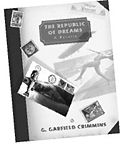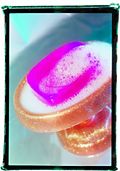DARRIN DANIEL FIRST met Harry Smith at the Naropa Institute. Daniel was studying poetics at the time; a friend of his was leaving town and asked him to look after Smith—in other words, to bring him a bowl of soup every day. Daniel didn’t know much about Smith: mainly that he was a filmmaker, a cantankerous genius (who, due to age and a throat injury, could only eat soft foods) who lived alone in a kind of hut on the Naropa campus. Fascinated and a little afraid, Daniel took the soup to Smith’s hut every day and left it just inside the door. One day, Smith stuck his head out and asked if Daniel had any marijuana.
A relationship was forged.
Think of the Self Speaking: Harry Smith—Selected Interviews (Elbow/Cityful Press, $16.95)
The story of the late Harry Smith is the story of a cranky master and his sometimes unwilling disciples. Smith, best known as the man who compiled the landmark Anthology of American Folk Music, was also known as a cosmographer, occultist, experimental filmmaker, artist, and inspiration. Those he inspired, it seemed, were also somewhat burdened by him; Allen Ginsberg said of seeing Smith on the street, “He looked at me and turned away—high, as if he’d seen the Devil. I was a little relieved, because every time I saw him he’d put the pressure on me for money.” Smith lived like Joseph Mitchell’s Joe Gould (though clearly less delusional): an unhinged genius, wandering from friend to friend, soliciting funds for art, for food, for drugs.
Smith himself may not figure largely in our recorded cultural history, but his impact is all over it. His experiments with filmmaking in the forties—such as painting right onto the film—gave birth to what is now known as the psychedelic graphics of the sixties. Artists as diverse as Bob Dylan and R. Crumb cite Smith’s influence, and legions of younger, more marginalized artists (filmmakers, folk singers) gravitate toward his work and his persona. And, not least, Smith from a young age was a kind of natural archivist, recording the music and language of the Lummi tribe near his Anacortes home. He obsessively collected the records from which the Anthology would later be drawn. He collected Ukrainian painted eggs, the visual/symbolic language of the Seminole Indians, the sounds of birds. This impulse—to archive, to curate, to create—stemmed from a belief that somehow all of these things were connected.
Smith’s own work is hard to find. By his own admission, he destroyed most of his paintings; there are few prints of his films (one of which Smith himself calls the “product of a deranged mind”), and they are rarely shown. But Daniel, of Cityful Press, and Steve Creson, of Elbow Press (both local publishers), have joined forces to bring out a book of interviews with Smith. The book, Think of the Self Speaking, is an excellent introduction to Smith, who might be called a Renaissance madman. In any given interview he is likely to list a dozen works of literature, scholarship, or art that you’ve never heard of, and just as likely to assault the interviewer with insults and try to evade the questions. In an interview with Gary Kenton, Smith tries his hardest to be slippery:
HS: Would you like me to read your fortune?
GK: Later.
HS: It’s bad.
GK: Now, talk to me a little bit about. . . .
HS: It’s bad.
IN OTHER INTERVIEWS, he is downright dotty; in one—a radio interview with P. Adams Sitney—he admits, “I took so much speed at noon that I just hope the program is over soon.” Still, for all his raving, he reminds one of the strength of the movements he inspired. Those Beat poets weren’t just smoking dope and riding back and forth across the country in a convertible. Many of those boys were conversant in a number of arts and took religion as seriously as they took literature.
Think of the Self Speaking, published this past February, is a large venture for two presses that over the past 10 years have brought out mostly chapbooks and broadsides. This volume may vault these two publishers from obscurity into a respectable world of cultural history and criticism; their next joint project, due out next year, is a book-length essay by scholar Jim Jones about the biographizing of Jack Kerouac—a sifting through the various tendencies to mythologize and demonize him. Plans are also in the works for a book of interviews with avant-garde filmmakers, and a reissue of the film criticism of Stan Brakhage, another Harry Smith devotee.
In an interview with Dawn Michelle Baude, Smith said, “Due to my own inability to cope with the world, I cannot find solutions. It’s as if the language was built incorrectly for discussing the subjects that I really want to discuss.” Think of the Self Speaking is a testament to his search for the right language, a search that moved across disciplines and subjects with surprising ease. To be introduced to Harry Smith is to be inducted into a world where everything is interesting and nothing is trivial. The interests of publishers Daniel and Creson promise that the works of lesser-known cultural figures will not go unnoticed.
Read our picks for the fall’s best books and book events.






